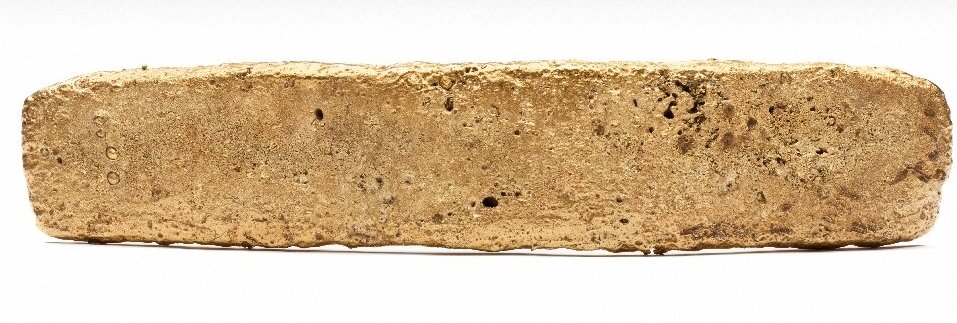Conny Waters – MessageToEagle.com – Researchers confirm now that “yew of gold” of the MNA (National Museum of Anthropology (Mexico) ), originates from the Spanish plunder in the so-called “Sad Night” (“Noche Triste”).
That night — June 30, 1520 — the Aztecs, furious over the slaughter of their nobles and priests, drove the Spanish invaders from their capital, Tenochtitlan.
As Dr. Leonardo López Luján, director of the Templo Mayor Project (PTM) informed, the analysis of the piece of gold was conducted by a team of the Institute of Physics of the UNAM, Mexico.

A 1.93-kilogram gold bar was part of the looted Aztec treasure. Image credit: INAH (Mexico’s National Institute of Anthropology)
A gold bar – which remained a mystery for 39 years – was found in a Mexico City park in 1981. It was part of the Aztec treasure looted by Hernan Cortes and the Spanish conquistadors 500 years ago. The 1.93-kilogram bar was discovered by a construction worker during excavations for a new building along the Alameda, a picturesque park in the heart of the Mexican capital.
See also: More Archaeology News
According to INAH, researchers from the National Autonomous University of Mexico (UNAM) in collaboration with Dr. José Luis Ruvalcaba, of the Institute of Physics (IF) used the portable equipment “Sandra”, endowed among other things, with X-ray Fluorescence (XRF), “a proven multi-elemental technique of high sensitivity, non-destructive, non-invasive and extremely fast.
“… we made 23 XRF readings in different regions of this piece and, as a consequence, we discovered that it was very chemically homogeneous: it had an average composition of 76.2 ± 1% gold, 20.8 ± 1% silver and 3.0 ± 0.5%, copper. If these values are compared with those recorded in the graph of Mesoamerican geographical areas of use, we will realize that the ingot is located within the group of pieces recovered by the Templo Mayor Project.
“Even more interesting,” he continued, “is that it is perfectly located in the region occupied by our later pieces, those of stage VI (1486-1502 AD), and particularly those found around the monolith of the goddess Tlaltecuhtli, as it is the case of offerings 122, 123,125 and 149. The foregoing is significant since the ingot would have been cast between 1519 and 1520 AD, ” Dr. López Luján said.
The battle of La Noche Triste (The Sad Night). source
“The so-called ‘Noche Triste’ is among the episodes of the conquest that will be remembered this year, and there is only one piece of material evidence from it: a gold bar that sank 500 years ago in the canals of Tenochtitlan, and which recent analysis confirms came from the (Spaniards’) flight,” INAH said in a statement.
See also:
Cuauhtémoc: Brave And Determined Ruler Of Tenochtitlan And The Last Aztec Emperor
Spanish Conquistadors Led By Hernan Cortés Entered The Aztecs Capital Tenochtitlán – On Nov 8, 1519
Massacre In Great Temple Of The Aztec Capital Tenochtitlan – On May 20, 1520
In 1519, Cortes and his men received a warm welcome from Aztec emperor Moctezuma when they arrived, but soon they became unwanted guests at the palace of the emperor.
“It is said that Cortés got the gold when he sought out Aztec emperor Moctezuma for his treasure,” CNN reports. A year after being welcomed into the capital city of Tenochtitlán, now Mexico City, he arrested the emperor and demanded all of his gold. Cortés and his men then melted the treasure down into bars.
The “Noche Triste” or “Sad Night” is a battle where Cortés tried to flee Tenochtitlan quietly on June 30, 1520, the night after Spaniards massacred Aztec leaders. The Aztecs learned of their plan and attacked. Some of the gold from Moctezuma’s treasure was lost in the battle.
The area where the gold bar was found is believed to be the location of an ancient canal that Cortés and his troops used to try to escape.
The study found the bar’s composition matched that of other Aztec pieces from the period.
The “golden yew” is exhibited today at the National Museum of Anthropology, “as a dramatic material witness of the Spanish Conquest and unique archaeological testimony of the so-called ‘Sad Night’,” Dr. López Luján said.
Written by Conny Waters – MessageToEagle.com – AncientPages.com Staff Writer
Expand for referencesReferences:







